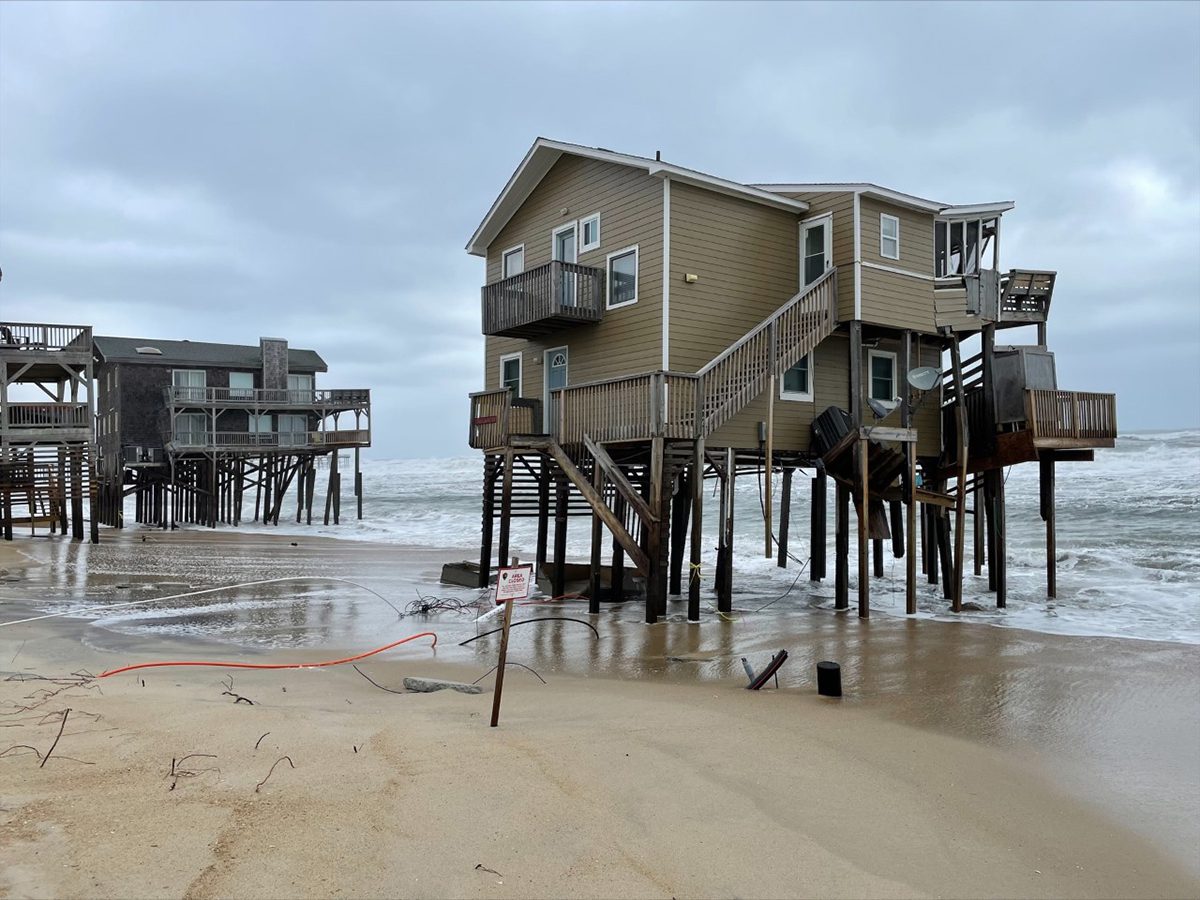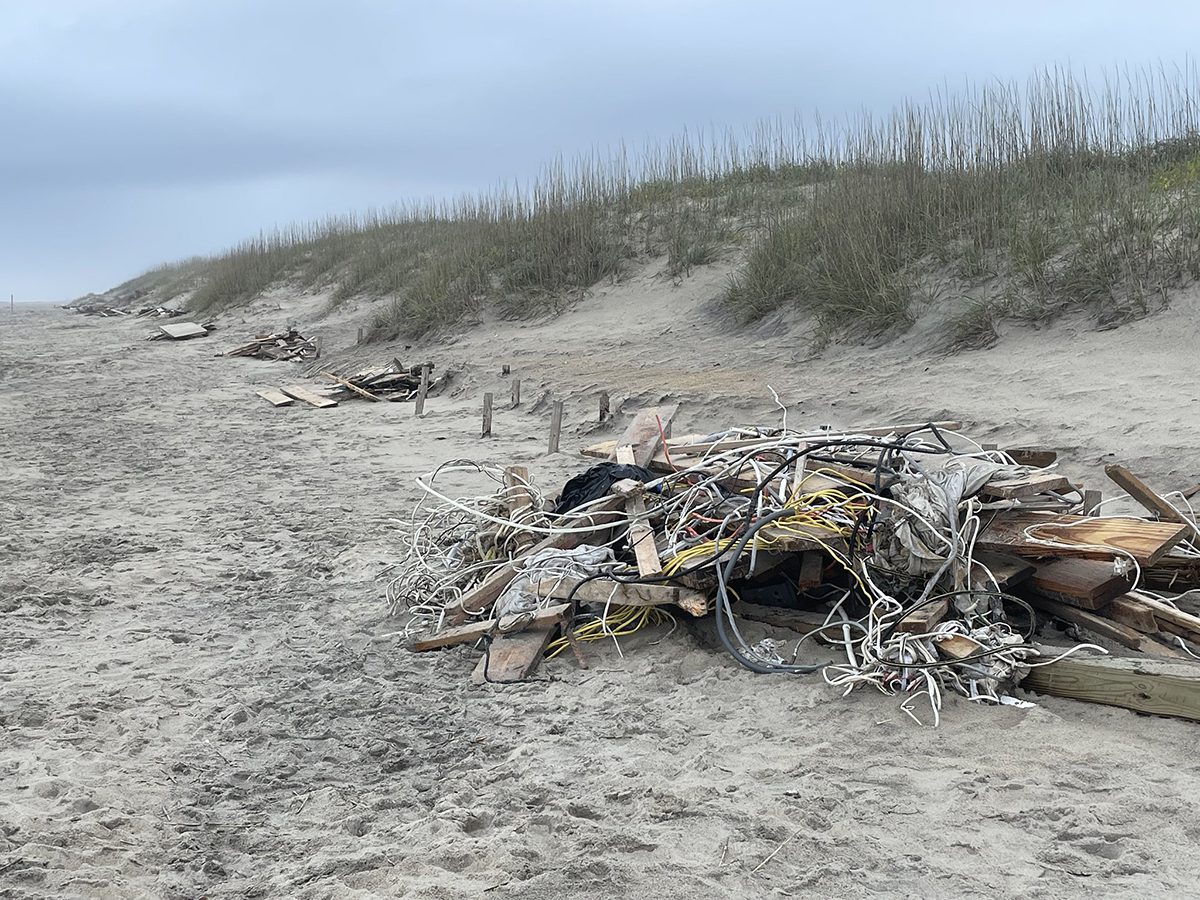
RODANTHE — Big houses falling into the ocean on the Outer Banks earlier this year had many people wondering why the government didn’t do more to proactively get the houses off the beach before they collapsed, with debris spreading for miles.
The changing climate has added urgency to already complex balances between private property rights and public trust issues. And instead of proactive measures, legal threats have instead resulted in apparent inaction.
Supporter Spotlight
“It’s very frustrating to look nationally and see we don’t have any great models for getting homes off the beach that are risk of collapsing,” Robert Young, director of the Program for the Study of Developed Shorelines at Western Carolina University, told Coastal Review last week.

As has happened in Nags Head and other beach areas, government measures are immediately met with lawsuits often with representation by legal advocates for private property rights that argue that such measures constitute a “taking” — essentially government taking private property for public use.
“There are very powerful interests that are seeking to protect this oceanfront resort economy,” Young said.
He noted a similar example happening in Harbor Island, South Carolina.
“They’re fighting over whose job it is to remove the houses,” Young said. “Everybody is suing everybody.”
Supporter Spotlight
In a May 31 op-ed in the Charlotte Observer, Young stated that climate change had increased the urgency to establish proactive coastal policies and encourage more realistic development.
Even though most oceanfront houses on the Outer Banks are investment properties, it is often the taxpayer and the local communities who pay the price when the houses collapse into the ocean. Only a small percentage of properties on the oceanfront are year-round homes, and the large majority are investment houses, Young said.
Young noted that some of the imperiled beach properties had sold within the past year. He pointed a finger at the real estate industry and the need for disclosure laws.
“So whose job is it?” Young asked during the interview, referring to removing teetering houses before they collapse. “I guess it’s God’s job.”
Willo Kelly, chief executive officer of the Outer Banks Association of Realtors, told Coastal Review that under North Carolina Real Estate Commission rules and standards, real estate agents have an ethical obligation to be truthful, but every risk is not necessarily apparent, predictable or even legal to talk about, such as a neighborhood crime rate.

Even federal flood insurance maps in North Carolina do not necessarily reflect the real risk, she said, so it is wise for prospective buyers to do their due diligence on oceanfront property.
“It’s not really that the house may be flooded — we have houses on pilings — but if (the ocean) pushes on pilings and the house falls, it’s flooded,” Kelly said, adding that the Outer Banks are undeniably dynamic barrier islands.
“Nobody is thinking that if you have an oceanfront house that it’s going to be there forever,” Kelly said. “This is the first year we’ve seen these numbers of houses that been impacted.”
After months of informal discussions on how to address the problem, Division of Coastal Management Director Braxton Davis and Cape Hatteras National Seashore Superintendent Dave Hallac are expected to elaborate on those discussions Thursday during the Coastal Resources Commission meeting in Wilmington.
Related: Coastal commission to discuss imperiled beach houses
Davis is expected to provide details of proposals to tighten regulations on septic tanks along the beachfront. Exposed tanks often create public health hazards on eroded beaches, especially after storms, as Davis notes in a memo to the commission included in the meeting agenda.
Davis, Hallac and others, including Dare County officials, have been part of discussions held by a recently formed interagency group to tackle the problem, including determination of the authority of federal and state agencies to take protective actions on their jurisdictional shorelines.
“The Work Group will engage with partner organizations and stakeholders to identify and research policies and programs to establish a proactive, holistic, predictable, and coordinated approach to erosion-threatened structures in North Carolina,” Davis explains in the memo. “The Work Group is planning to meet regularly in the coming year and produce a report outlining short- and long-term solutions.”
As erosion increases with rising seas, and with climate change intensifying storms, more oceanfront structures have encroached on public beaches, Davis notes in the memo. Based on an agency review of 2020 imagery, he said, “over 750 of approximately 8,777 oceanfront structures were considered at risk from oceanfront erosion (no dunes or vegetation between the structure and ocean.)”

Hallac told Coastal Review that preventing the problem in the first place is the goal.
It’s not just destruction of the houses, Hallac said, it’s also about the long-term effects on the public and the natural resources in and along Cape Hatteras National Seashore. After the houses fell into the surf earlier this year, debris stretched for 15 miles up and down the beach, as well as in the ocean and on private property, and dozens of destroyed or damaged septic tanks were strewn along the beach.
“We still have a debris problem from the houses that collapsed in May,” Hallac said recently. “There are thousands and thousands of pieces of tar paper and carpet padding up to 4 miles from the house collapse site.”
The park has had to purchase a $40,000 beach rake to sift debris from the sand and has spent a “substantial” amount in cleanup costs in addition to what the property owners paid for a contractor to clean the debris.
Erosion has complicated where the national seashore boundaries exist, but in general, Hallac said, the park is understood to have jurisdiction of the beach between the high- and low-tide lines.
“Their backyards now are essentially in the Atlantic Ocean,” he said. “Fences, retaining walls, decks, lighting are in the national seashore.”
When Dare County notified the national seashore officials about the risk, Hallac said that 24 property owners were then notified and asked to do whatever was possible to prevent their houses from being destroyed, such as having it removed or demolished.
Several homes have been moved from the beach, either back on their own lot, or on a new lot, or are in the process of planning to move.
With severe beach erosion, houses don’t need a storm to push them into the sea — they can be undermined and collapse just from wave action on clear day. The most recent collapse happened when winds had maxed out at 30 mph.
“We’re beginning to get our arms around the magnitude of the threat,” Hallac said.
Meanwhile, the agency is researching and evaluating the park’s authority and long-term options in addressing protection of the national seashore.
Looming over past discussions has been the threat of lawsuits.
Sierra Weaver, senior attorney with the nonprofit Southern Environmental Law Center in Chapel Hill, said that the federal, state and local governments have the authority and responsibility to protect the public.

Weaver said that what’s known as a “taking” is a complicated legal concept, but it’s not when the ocean does the taking.
“North Carolina state law is very clear that when an ocean takes a person’s property, it’s not the government taking the person’s property, that is the ocean taking a person’s property,” she told Coastal Review. “And because of that, when you’re faced with erosion that takes down a person’s house, you’re looking at natural acts of the ocean. And so North Carolina law is set up to ensure we’re protecting public safety in the face of a dynamic coastline.”
Weaver said the recent house collapses were a wakeup call to all levels of government. That includes increased transparency and disclosure on the part of real estate agents.
“This is one of those things that is becoming really a hot topic across the country at the state and federal levels, is how can homeowner disclosure requirements be strengthened to ensure that we stop this cycle of people either not knowing that there’s a problem or claiming that they know that there’s a problem?” she continued. “That is, is the buyer unaware that there’s a problem? Or are they fully aware that houses are washing into the ocean, but they’re gambling that they’re make enough in rent before the ocean is lost, and then collect on flood insurance?”
She said the long-term answer is in changing the incentive structure for homes on the coast, “so we stop this cycle of people simply looking to make money rather than looking to protect those public trust resources that we all value so much.”
Weaver said the takings concept is “a world full of balancing tests and multiple considerations” that becomes “very murky very quickly.” It’s site-specific.
“There’s just a lot of factors that come into play that make it very, very difficult to talk about any particular situation until it’s right in front of you,” she said.







